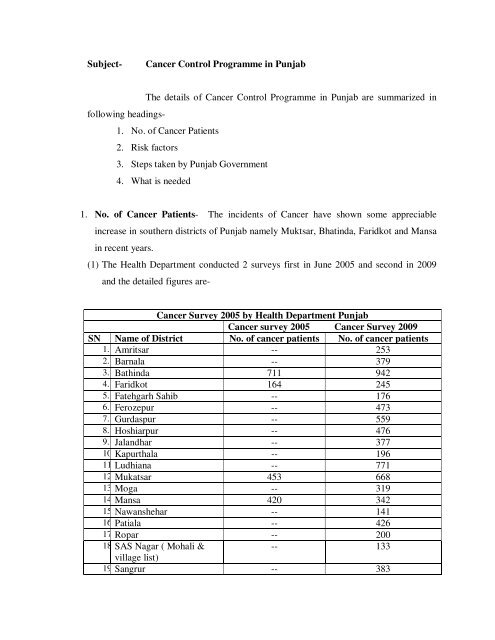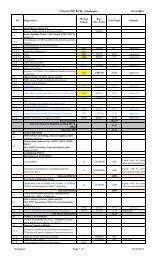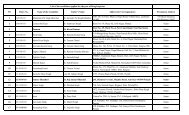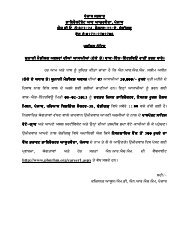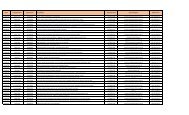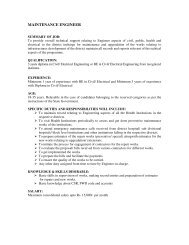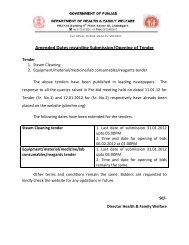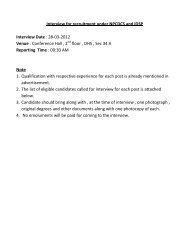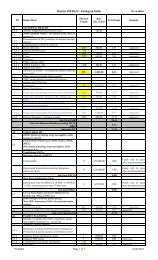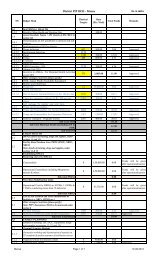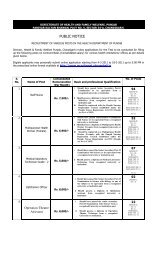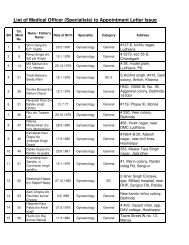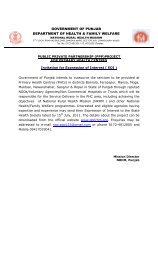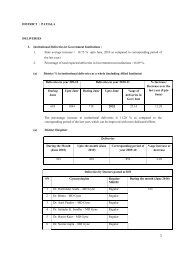Subject- Cancer Control Programme in Punjab The details of ...
Subject- Cancer Control Programme in Punjab The details of ...
Subject- Cancer Control Programme in Punjab The details of ...
You also want an ePaper? Increase the reach of your titles
YUMPU automatically turns print PDFs into web optimized ePapers that Google loves.
<strong>Subject</strong>-<br />
<strong>Cancer</strong> <strong>Control</strong> <strong>Programme</strong> <strong>in</strong> <strong>Punjab</strong><br />
<strong>The</strong> <strong>details</strong> <strong>of</strong> <strong>Cancer</strong> <strong>Control</strong> <strong>Programme</strong> <strong>in</strong> <strong>Punjab</strong> are summarized <strong>in</strong><br />
follow<strong>in</strong>g head<strong>in</strong>gs-<br />
1. No. <strong>of</strong> <strong>Cancer</strong> Patients<br />
2. Risk factors<br />
3. Steps taken by <strong>Punjab</strong> Government<br />
4. What is needed<br />
1. No. <strong>of</strong> <strong>Cancer</strong> Patients- <strong>The</strong> <strong>in</strong>cidents <strong>of</strong> <strong>Cancer</strong> have shown some appreciable<br />
<strong>in</strong>crease <strong>in</strong> southern districts <strong>of</strong> <strong>Punjab</strong> namely Muktsar, Bhat<strong>in</strong>da, Faridkot and Mansa<br />
<strong>in</strong> recent years.<br />
(1) <strong>The</strong> Health Department conducted 2 surveys first <strong>in</strong> June 2005 and second <strong>in</strong> 2009<br />
and the detailed figures are-<br />
<strong>Cancer</strong> Survey 2005 by Health Department <strong>Punjab</strong><br />
<strong>Cancer</strong> survey 2005 <strong>Cancer</strong> Survey 2009<br />
SN Name <strong>of</strong> District No. <strong>of</strong> cancer patients No. <strong>of</strong> cancer patients<br />
1. Amritsar -- 253<br />
2. Barnala -- 379<br />
3. Bath<strong>in</strong>da 711 942<br />
4. Faridkot 164 245<br />
5. Fatehgarh Sahib -- 176<br />
6. Ferozepur -- 473<br />
7. Gurdaspur -- 559<br />
8. Hoshiarpur -- 476<br />
9. Jalandhar -- 377<br />
10.Kapurthala -- 196<br />
11.Ludhiana -- 771<br />
12.Mukatsar 453 668<br />
13.Moga -- 319<br />
14.Mansa 420 342<br />
15.Nawanshehar -- 141<br />
16.Patiala -- 426<br />
17.Ropar -- 200<br />
18.SAS Nagar ( Mohali &<br />
-- 133<br />
village list)<br />
19.Sangrur -- 383
20.Tarn Taran -- 279<br />
Total 1748 7738<br />
(2) PGI had conducted a study <strong>in</strong> Talwandi Sabo Block <strong>in</strong> 2002 and the number <strong>of</strong><br />
<strong>Cancer</strong> patients was found to be 125 per lac. If we extrapolate these figures then the<br />
number <strong>of</strong> <strong>Cancer</strong> patients <strong>of</strong> the entire population <strong>of</strong> entire Bath<strong>in</strong>da District <strong>of</strong> 12.55<br />
lac would be 1574. And for 4 districts namely Bath<strong>in</strong>da, Faridkot, Muktsar and<br />
Mansa with a total population <strong>of</strong> 32 lacs, there would be 4012 patients <strong>of</strong> cancer who<br />
needed urgent treatment. <strong>The</strong> PGI survey was much more detailed and was<br />
conducted by Department <strong>of</strong> Community Medic<strong>in</strong>es for one block. <strong>The</strong> house to<br />
house survey was conducted by Health Department by ANMs and Multi Purpose<br />
Health Workers and it is quite possible that <strong>in</strong> some <strong>of</strong> the villages they did not<br />
capture the actual figures. <strong>The</strong> Health Department will have some <strong>of</strong> villages resurveyed,<br />
then the correct picture might emerge.<br />
(3) Roko <strong>Cancer</strong> <strong>Programme</strong>- A Roco <strong>Cancer</strong> <strong>Programme</strong> is <strong>in</strong> progress <strong>in</strong> Malwa belt<br />
for detection <strong>of</strong> Breast <strong>Cancer</strong> <strong>in</strong> women. Survey report <strong>of</strong> three months <strong>of</strong> screen<strong>in</strong>g<br />
is as below:-<br />
(i) Total population covered 1,64,666<br />
(ii) Women exam<strong>in</strong>ed 9180<br />
(iii) Mammography done 995<br />
(iv)<br />
Suspected cases <strong>of</strong> breast cancer <strong>in</strong> the<br />
above population 76<br />
Breast cancer be<strong>in</strong>g 15% <strong>of</strong> total cancer cases therefore total cancer cases <strong>in</strong> the above<br />
population will be 76X 7 =532.<br />
Tak<strong>in</strong>g this mean average total number <strong>of</strong> cases <strong>in</strong> Bath<strong>in</strong>da district with the population <strong>of</strong><br />
1255932 will be 4057.<br />
Tak<strong>in</strong>g all these above three methods <strong>of</strong> calculat<strong>in</strong>g cancer cases <strong>in</strong> Bath<strong>in</strong>da district the<br />
average is far above the National Levels. It may therefore be seen that the number <strong>of</strong>
cancer patients <strong>in</strong> these districts might vary from 100 to 200 which is much above the<br />
average <strong>of</strong> 70 per lac population.<br />
2. Risk factors-<br />
<strong>The</strong> cancer cases <strong>of</strong> Bath<strong>in</strong>da were analyzed and the lead<strong>in</strong>g cases <strong>of</strong> cancer patients<br />
were found to be as follows-<br />
Lead<strong>in</strong>g sites <strong>of</strong> <strong>Cancer</strong> <strong>in</strong> District Bath<strong>in</strong>da<br />
S.No. Male Female<br />
Lead<strong>in</strong>g site Number Lead<strong>in</strong>g site Number<br />
1 Oesophagus 28 Breast 68<br />
2 Mouth 10 Cervix Uteri 60<br />
3 Tongue 9 Ovary 13<br />
4 Prostate 8 Myel Leuk 11<br />
5 Myel Leuk 8 Oesophagus 10<br />
6 Lymph.Leuk 8 Gallbladder 7<br />
7 Conn. Tissue 7 Hypopharynix 4<br />
8 Bladder 7 Tongue 4<br />
9 Ractum 6 Oth.Sk<strong>in</strong> 4<br />
10 Oth. Sk<strong>in</strong> 6 Conn.Tissue 4<br />
Total 183 Total 241<br />
Important Risk Factors caus<strong>in</strong>g cancer- <strong>The</strong> important risk factors caus<strong>in</strong>g cancer are-<br />
Accord<strong>in</strong>g to epidemiological studies, 80-90% <strong>of</strong> all cancers are due to environmental<br />
factors <strong>of</strong> which, lifestyle related factors are the most important and preventable. Causation <strong>of</strong><br />
cancer is multi-factorial.<br />
(1) Environmental Factors: these are generally held responsible for 80-90% <strong>of</strong> all<br />
cancers. <strong>The</strong> major environmental factors <strong>in</strong>clude:-<br />
(2) Tobacco: Tobacco <strong>in</strong> various forms <strong>of</strong> usage <strong>of</strong> smok<strong>in</strong>g, chew<strong>in</strong>g etc. is the major<br />
environmental cause <strong>of</strong> cancers <strong>of</strong> the lung, larynx, mouth, pharynx, esophagus, lip,<br />
ur<strong>in</strong>ary bladder, pancreas, uterus, cervix, breast and kidney also. In India more than
40% <strong>of</strong> cancer cases are due to tobacco.. Smok<strong>in</strong>g is by far the lead<strong>in</strong>g risk factor for<br />
lung cancer. If a person doesn't smoke but breathes <strong>in</strong> the smoke <strong>of</strong> others (called<br />
passive smok<strong>in</strong>g or second hand smoke), he is also at an <strong>in</strong>creased risk <strong>of</strong> lung cancer.<br />
Smokeless tobacco i.e. snuff and chew<strong>in</strong>g tobacco also conta<strong>in</strong>s 28 carc<strong>in</strong>ogens i.e.<br />
cancer caus<strong>in</strong>g agents..Other than lung cancer, tobacco use has also been l<strong>in</strong>ked to<br />
Head and Neck <strong>Cancer</strong>s, Ur<strong>in</strong>ary bladder & kidneys, Cervix & Breast, and Colon<br />
(3) Alcohol: - excessive <strong>in</strong>take <strong>of</strong> alcoholic beverages is associated with esophageal and<br />
liver cancer. Some studies have also suggested that beer consumption may be<br />
associated with rectal cancer. It is estimated that alcohol contributes to about 3% <strong>of</strong> all<br />
cancer deaths. Alcohol consumption is l<strong>in</strong>ked to the follow<strong>in</strong>g cancers:<br />
– Breast cancer <strong>in</strong> women<br />
– Primary liver cancer<br />
– Ovarian cancer<br />
– Prostate cancer<br />
– Thyroid cancer<br />
(4) Dietary factors: smoked fish may be related to stomach cancer, lack <strong>of</strong> dietary fiber to<br />
<strong>in</strong>test<strong>in</strong>al cancer, beef consumption to bowel cancer, high fat diet to breast cancer.<br />
Food additives and contam<strong>in</strong>ants may also be the causative agents.<br />
(5) Occupational exposures: accounts for one to five % <strong>of</strong> all human cancers. <strong>The</strong>se<br />
<strong>in</strong>clude exposure to benzene, arsenic, cadmium, chromium, asbestos, polycyclic hydro<br />
carbons.<br />
(6) Viruses: Hepatitis B & C may lead to hepatic cancer. HIV virus may lead to Kaposi<br />
Sarcoma. <strong>The</strong> Ebste<strong>in</strong> Barr virus is associated with Burkitt's lymphoma and<br />
nasopharyngeal carc<strong>in</strong>oma. Hodgk<strong>in</strong> disease is also believed to be caused by virus.<br />
(7) Parasites: Parasitic <strong>in</strong>fections may <strong>in</strong>crease the risk <strong>of</strong> cancer e.g. schistosomiasis <strong>in</strong><br />
Middle East produc<strong>in</strong>g carc<strong>in</strong>oma <strong>of</strong> the bladder.<br />
(8) Others: environmental factors e.g. sunlight, radiation air pollution and water<br />
pollution, medication; pesticides etc are related to cancer.<br />
(9) Customs, habits & life styles: familiar examples are association between smok<strong>in</strong>g<br />
and lung cancer, tobacco & betel chew<strong>in</strong>g & oral cancer etc.
(10) Genetic factors: genetic <strong>in</strong>fluences have long been suspected e.g. ret<strong>in</strong>oblastoma<br />
occurs <strong>in</strong> children <strong>of</strong> the same parent, Mongols are more likely to develop cancer<br />
(leukemia) than normal children. However genetic factors are less conspicuous and<br />
more difficult to identify.<br />
3. Steps taken by <strong>Punjab</strong> Government- <strong>The</strong> State Government has taken or is tak<strong>in</strong>g the<br />
follow<strong>in</strong>g steps to deal with the <strong>Cancer</strong> cases <strong>in</strong> the State-<br />
(1) Population Based <strong>Cancer</strong> Registry- <strong>The</strong> State Government has been pursu<strong>in</strong>g the case<br />
for sanction <strong>of</strong> Population Based Registry. Indian Council <strong>of</strong> Medical Research has now<br />
agreed to sanction this registry <strong>in</strong> Government Medical College Patiala. This is a Five<br />
Year Project cost<strong>in</strong>g Rs. 45 lacs. <strong>The</strong> date <strong>of</strong> cancer patients would be ma<strong>in</strong>ta<strong>in</strong>ed.<br />
(2) Hospitals Based <strong>Cancer</strong> Registry - Hospitals Based <strong>Cancer</strong> Registry has been<br />
sanctioned <strong>in</strong> PGI.<br />
(3) Upgradation <strong>of</strong> Medical Colleges- <strong>The</strong> 3 Government Medical Colleges <strong>in</strong> the State<br />
have been Rs. 2 Crore and Rs. 3 Crore by the Government <strong>of</strong> India under <strong>Cancer</strong> <strong>Control</strong><br />
<strong>Programme</strong> and the facilities are be<strong>in</strong>g upgraded.<br />
(4) Cash Assistance- A sum <strong>of</strong> Rs. 25 lacs was sanctioned for treatment <strong>of</strong> <strong>Cancer</strong> patients<br />
<strong>in</strong> Bath<strong>in</strong>da District. An amount <strong>of</strong> Rs. 17.92 lacs has been spent by the Deputy<br />
Commissioner, Bath<strong>in</strong>da for the year 2009.<br />
(5) <strong>Punjab</strong> State Illness Fund- <strong>Cancer</strong> patients belong<strong>in</strong>g to BPL families can be given upto<br />
Rs. 1.5 lac for treatment <strong>of</strong> <strong>Cancer</strong> patients <strong>in</strong> Government Hospitals.Rs. 18.25 lac has<br />
been spent cancer cases.<br />
(6) Roko <strong>Cancer</strong>- An agreement was signed with a NGO namely Roko <strong>Cancer</strong> <strong>in</strong> February,<br />
2010 for one year for screen<strong>in</strong>g <strong>of</strong> women for breast cancer. <strong>The</strong> NGO has deployed an<br />
Mobile Medical Unit for Memography for screen<strong>in</strong>g <strong>of</strong> <strong>Cancer</strong> patients <strong>in</strong> the 4 districts <strong>of</strong><br />
Mukatsar, Mansa, Bath<strong>in</strong>da and Faridkot. <strong>The</strong> <strong>details</strong> <strong>of</strong> their work have been given <strong>in</strong><br />
para –(3 ) <strong>of</strong> Roko <strong>Cancer</strong> <strong>Programme</strong>.<br />
(7) Reverse Osmosis- <strong>The</strong> State Government has spent a sum <strong>of</strong> Rs. 34 Crore for <strong>in</strong>stallation<br />
<strong>of</strong> Reverse Osmosis Systems (RO) <strong>in</strong> villages <strong>of</strong> the 4 districts where the quality <strong>of</strong>
dr<strong>in</strong>k<strong>in</strong>g water is not good. 340 villages have already been covered and more villages<br />
will be covered under this scheme <strong>in</strong> this year.<br />
(8) ONCONET Service- Telemedic<strong>in</strong>e- is to be established by Government <strong>of</strong> India Regional<br />
<strong>Cancer</strong> Centre, PGI will be connected to four District Hospitals namely Hoshiarpur,<br />
Sangrur, Bath<strong>in</strong>da and Muktsar for this service.<br />
(9) Max Hospitals at Bath<strong>in</strong>da and Mohali- <strong>The</strong> State Government has provided fund and<br />
land to Civil Hospitals for construction <strong>of</strong> hospitals by Max Hospital Care under Public<br />
Private Participation. <strong>The</strong> 2 Hospitals will be ready by 31/12/2010. <strong>The</strong> State <strong>of</strong> art<br />
Facilities for treatment <strong>of</strong> <strong>Cancer</strong> patients would be available at both these hospitals.<br />
4. What is needed- <strong>The</strong> facilities available for <strong>Cancer</strong> patients are <strong>in</strong>adequate. <strong>The</strong> State<br />
Government requires the follow<strong>in</strong>gs th<strong>in</strong>gs to do-<br />
(1) F<strong>in</strong>ancial Assistance to <strong>Cancer</strong> patients- At present except for BPL families<br />
there is no Government scheme under which f<strong>in</strong>ancial assistance can be provided to the<br />
cancer patients. <strong>The</strong> Government scheme as expla<strong>in</strong>ed <strong>in</strong> the next paragraph is grossly<br />
<strong>in</strong>adequate. Approximate a sum <strong>of</strong> Rs. 40 Crore is required for treatment <strong>of</strong> cancer<br />
patients and therefore a permanent fund should be set up for treatment <strong>of</strong> cancer patients.<br />
<strong>The</strong>re are approximately 4000 cases at the rate <strong>of</strong> 125 cases per lac <strong>of</strong> population <strong>in</strong><br />
these 4 districts.<br />
(2) <strong>Punjab</strong> Illness Fund- This fund is contributed by Government <strong>of</strong> India and the<br />
State Government <strong>in</strong> the ratio <strong>of</strong> 2:1. We have about Rs. 1.5 Crore <strong>of</strong> amount <strong>in</strong> the<br />
year but this scheme has two limitations- first only BPL families are eligible for f<strong>in</strong>ancial<br />
assistance under this scheme that that too only for Rs. 1.25 lac. Second limitation is that<br />
f<strong>in</strong>ancial assistance is given for treatment <strong>in</strong> Government Hospitals only. BPL families<br />
are very limited <strong>in</strong> number and other poor people are deprived <strong>of</strong> this f<strong>in</strong>ancial assistance.<br />
<strong>The</strong> Government medical colleges <strong>in</strong> the State are not well equipped and even today large<br />
number <strong>of</strong> patients <strong>in</strong> these districts go to Bikaner for treatment. It is requested that the<br />
eligibility criteria under <strong>Punjab</strong> Illness Fund which is a Government <strong>of</strong> India scheme<br />
should be relaxed and the reputed hospitals like DMC Ludhiana, CMC Ludhiana and<br />
Oswal <strong>Cancer</strong> Hospital Ludhiana should be allowed.
(3) Upgradation <strong>of</strong> District Hospitals- <strong>The</strong> Government <strong>of</strong> India is formulat<strong>in</strong>g a<br />
scheme for upgradation <strong>of</strong> selected District Hospitals for treatment <strong>of</strong> <strong>Cancer</strong>. It is<br />
requested that guidel<strong>in</strong>es for this scheme may be f<strong>in</strong>alized at the earliest and the District<br />
Hospitals <strong>in</strong> these 4 districts should be upgraded under this scheme.<br />
(4) Reverse Osmosis System- To provide safe dr<strong>in</strong>k<strong>in</strong>g water RO systems and<br />
amount <strong>of</strong> Rs. 57.50 Crore @ Rs.10.00 lacs per village is required to be provided for the<br />
rema<strong>in</strong><strong>in</strong>g 575 villages <strong>of</strong> four districts.<br />
(Satish Chandra)<br />
Pr<strong>in</strong>cipal Secretary Health and Family Welfare<br />
28/6/2010


